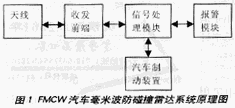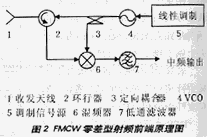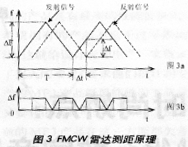Automobile anti-collision system is very important to improve the safety of automobile driving, and the research of this system has been paid much attention to. Since 1971, there have been active automobile anti-collision systems in various ways such as ultrasound, laser, infrared, microwave, etc., but the above systems have some deficiencies, and they have not been widely applied in automobiles. With the rapid development of highway networks in various countries, vicious traffic accidents continue to increase. In order to reduce accidents, protective measures such as driving seat belts and airbags have been adopted. However, these technologies are passive protection and cannot fundamentally solve the problem. Millimeter wave refers to electromagnetic waves with a wavelength between 1 and 10 mm, and its RF bandwidth is large,  The high resolution and small antenna components can adapt to harsh environments. Therefore, the millimeter-wave radar system has the characteristics of light weight, small size and all-weather. The "active automotive millimeter-wave anti-collision radar system" has become a hot spot for international research and development in recent years , And already products have begun to enter the market, the prospects are very promising.
The high resolution and small antenna components can adapt to harsh environments. Therefore, the millimeter-wave radar system has the characteristics of light weight, small size and all-weather. The "active automotive millimeter-wave anti-collision radar system" has become a hot spot for international research and development in recent years , And already products have begun to enter the market, the prospects are very promising.
This article introduces the principle of active automobile anti-collision millimeter wave radar, and reports on the SAE-100 millimeter wave anti-collision radar prototype we have developed.
Principle of millimeter wave radar system for automobile collision avoidance
Active car anti-collision is based on radar ranging and speed measurement. The anti-collision radar system monitors the front of the vehicle in real time. When a dangerous target (such as a vehicle stopping or moving ahead) appears, the radar system sends an alarm to the driver in advance so that the driver can react in time, and the radar output signal reaches the car control system. Automatic braking or deceleration according to the situation.
Millimeter-wave anti-collision radar systems include frequency-modulated continuous wave (FMCW) radar and pulse radar. For the pulse radar system, when the target is very close, the time difference between the transmitted pulse and the received pulse is very small, which requires the system to use high-speed signal processing technology, the short-range pulse radar system becomes very complicated, and the cost also rises significantly. Therefore, the automobile millimeter wave radar anti-collision system often adopts a FM continuous wave radar system with simple structure and low cost, which is suitable for short-range detection.
Millimeter wave FMCW radar system structure
The FMCW automotive radar system is shown in Figure 1, which includes an antenna, a transceiver module, a signal processing module, an alarm module or an automobile braking device.  The RF transceiver front-end is the core component of the radar system. A lot of in-depth research has been conducted on the front end at home and abroad, and considerable progress has been made. The front end of various structures has been developed, including the front end of the waveguide structure, the front end of the microstrip structure and the monolithic integration of the front end. The RF front end developed in China is mainly the front end of the waveguide structure. A typical RF front-end mainly includes three parts: linear VCO, circulator and balanced mixer, as shown in Figure 2. The intermediate frequency signal output by the front-end mixer is sent to the post-stage data processing section through the intermediate frequency amplification. The basic goal of the data processing section is to eliminate unnecessary signals (such as clutter) and interfering signals, and process the mixed signal after intermediate frequency amplification to extract target distance and speed information from the signal spectrum.
The RF transceiver front-end is the core component of the radar system. A lot of in-depth research has been conducted on the front end at home and abroad, and considerable progress has been made. The front end of various structures has been developed, including the front end of the waveguide structure, the front end of the microstrip structure and the monolithic integration of the front end. The RF front end developed in China is mainly the front end of the waveguide structure. A typical RF front-end mainly includes three parts: linear VCO, circulator and balanced mixer, as shown in Figure 2. The intermediate frequency signal output by the front-end mixer is sent to the post-stage data processing section through the intermediate frequency amplification. The basic goal of the data processing section is to eliminate unnecessary signals (such as clutter) and interfering signals, and process the mixed signal after intermediate frequency amplification to extract target distance and speed information from the signal spectrum.
Millimeter wave FMCW radar ranging and speed measurement principle
The radar system transmits a series of continuously frequency-modulated millimeter waves through the antenna and receives the reflected signal of the target. The frequency of the transmitted wave changes with time according to the law of the modulation voltage. Generally, the modulated signal is a triangular wave signal, and the frequency change of the transmitted signal and the received signal is shown in FIG. 3a. The shape of the reflected wave and the transmitted wave are the same, but there is a delay in time (t, (The relationship between t and the target distance R can be expressed as
â–³ t = 2R / c (1)
Where c: speed of light  The frequency difference between the transmitted signal and the reflected signal at a certain moment is the frequency of the intermediate frequency signal (f (Figure 3b) output from the mixing output. According to the triangle relationship, the target distance R can be obtained from Figure 3a
The frequency difference between the transmitted signal and the reflected signal at a certain moment is the frequency of the intermediate frequency signal (f (Figure 3b) output from the mixing output. According to the triangle relationship, the target distance R can be obtained from Figure 3a
R = (cT / 4 â–³ F) â–³ f (2)
In other words, the target distance is proportional to the intermediate frequency output by the front end.
If the reflected signal comes from a relatively moving target, the reflected signal includes a Doppler frequency shift fd caused by the relative motion of the target (see Figure 4). The output intermediate frequency at the rising and falling edges of the triangle wave can be expressed as
fb + = â–³ f-fd (3)
fb- = â–³ f + fd (4)
In the formula-(f: IF frequency when the target is relatively stationary; fd: Doppler frequency shift, its sign is related to the direction of relative motion of the target.
According to the Doppler principle, the relative velocity v of the target is
v = c / 4f0 (fb--fb +)  = λ (fb--fb +) (5)
= λ (fb--fb +) (5)
Where-f0: center frequency of the transmitted wave;: wavelength of the transmitted wave.
The sign of the speed v is related to the direction of the relative motion of the target. When the target is close, v is positive, otherwise v is negative. The frequency of the intermediate frequency signal at the rising and falling edges of the triangle wave is obtained by the FFT transform of the DSP.
From formulas (2) and (5), the target distance and the relative speed of the target can be calculated.
Development of SAE-100 millimeter wave anti-collision radar system
After nearly a year of research, the Shanghai Automotive Electronics Engineering Center has developed a prototype of the SAE-100 millimeter-wave anti-collision radar system. The prototype uses the homodyne FMCW system, the system structure is shown in Figure 1, the operating frequency is 35GHz, and the ranging range is> 100m.  Speed ​​measurement range> 100km / h. The system uses a small horn antenna with a gain of 26dB, a front end of a waveguide structure with a transmission power of 40mW, and advanced DSP data processing technology. The upper part includes the antenna, front end and intermediate frequency amplification module, the size is 19cm (15cm (16cm, the output signal is the amplified intermediate frequency signal. The lower part is the data processing and display alarm module, which can display the target distance and relative movement speed. When the distance is less than 100m, three different tones can be used for alarm according to the distance.
Speed ​​measurement range> 100km / h. The system uses a small horn antenna with a gain of 26dB, a front end of a waveguide structure with a transmission power of 40mW, and advanced DSP data processing technology. The upper part includes the antenna, front end and intermediate frequency amplification module, the size is 19cm (15cm (16cm, the output signal is the amplified intermediate frequency signal. The lower part is the data processing and display alarm module, which can display the target distance and relative movement speed. When the distance is less than 100m, three different tones can be used for alarm according to the distance.
ZhenHuan`s line of ac-dc power supplies output power ranging from 3 W to 200 W is available in a variety of wall plug-in and desktop adapter configurations to meet your needs. From our low power international Wall Plug Adapters to our high power desktop ac-dc power adapters, we ensure that the majority of our external power supplies not only comply with the current energy efficiency Level VI standards, but also meet global safety certifications.
Power Adapter 12V,Ac Dc Adapter,Camera Adaptor,Dc 12V Adapter For Laptop,19V Power Supply,18V DC Adapters
Shenzhenshi Zhenhuan Electronic Co Ltd , https://www.szzhpower.com